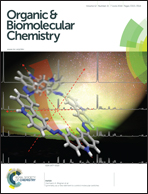Benzo[a]acridinylmethyl esters as pH sensitive fluorescent photoactive precursors: synthesis, photophysical, photochemical and biological applications†
Abstract
A newsworthy class of carboxylate esters based on the (benzo[a]acridin-12-yl)methyl (BAM) chromophore has been shown to perform dual functions as a “pH sensitive fluorescent probe” and a “phototrigger” for acids. The photophysical properties of all the BAM ester conjugates were investigated and found to be highly sensitive to solvent polarity, H-bonding capability and pH of the environment. On irradiation using UV light (≥410 nm), BAM ester conjugates underwent heterolytic cleavage of C–O bonds resulting in efficient release of carboxylic and amino acids. Interestingly, the newly synthesized BAM chromophore was also explored for the construction of a drug delivery system (DDS). In the current DDS, the BAM chromophore plays two important roles: (i) a “fluorophore” for cell imaging and (ii) a “phototrigger” for the drug release. In vitro biological studies revealed that the newly developed BAM based DDS has a good biocompatibility, cellular uptake properties and efficient photoregulated anticancer drug release ability.
![Graphical abstract: Benzo[a]acridinylmethyl esters as pH sensitive fluorescent photoactive precursors: synthesis, photophysical, photochemical and biological applications](/en/Image/Get?imageInfo.ImageType=GA&imageInfo.ImageIdentifier.ManuscriptID=C3OB42600A&imageInfo.ImageIdentifier.Year=2014)

 Please wait while we load your content...
Please wait while we load your content...